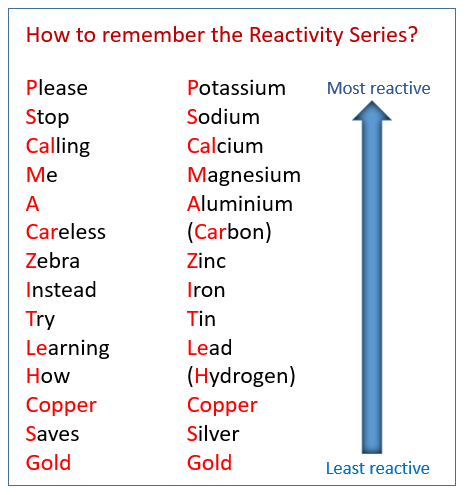Types of Reactions
Decomposition Reactions
- Decomposition reactions involve breaking down one compound into 2 or more simpler substances
- Decomposition is an ENDOTHERMIC reaction, meaning it reuqires heat input
- An example of a decomposition reaction is carbonate decomposition:
Decomposition by light
- Some compounds will decompose when exposed to light
- An example is Silver Nitrate (
- Light-based decomposition is the basis of film photography
Combustion Reactions
- Combustion reactions occur when something burns
- Combustion reactions are EXOTHERMIC (i.e. light, sound, heat are usually produced)
- Oxygen (or any oxidizer) is always a component of a combustion reaction
- An example of a combustion reaction is burning Propane:
- Some combustion reactions only have
- These are known as “complete combustion reactions”
- An example of a complete combustion reaction is burning Methane:
Precipitation Reactions
- When soluble ionic compounds are dissolved in water, the lattice “dissolves”, and the ions are separated

- If two solutions are mixed together, it’s really just 4 different ions suspended in water
- However, certain combinations of ions will form an insoluble compound when mixed
- These compounds will form a PRECIPITATE, a small ionic crystal lattice
- This is known as a precipitation reaction
- An example is mixing sodium sulfide and copper sulfate solutions:
Solubility Rules
The solubility rules are used to determine which compound is the precipitate.
| Ion | Soluble? | Exceptions |
|---|---|---|
| ✅ | ❌ | |
| ✅ | ❌ | |
| ✅ | ||
| ✅ | ||
| ✅ | ||
| ❌ | Alkalis and Ammonium | |
| ❌ | Alkalis and Ammonium | |
| ❌ | Alkalis, | |
| ❌ | Alkalis, Alkaline Earths, Ammonium | |
| ✅ | ❌ | |
| ✅ | ❌ | |
| ✅ | ❌ |
NAGSAG and PMS (Mnemonics)
- NAGSAG can be used to remember common soluble ions:
N - Nitrates (
) A - Acetates (
) G - Group 1 (
) S - Sulfates (
) A - Ammonium (
) G - Group 17 (
)
- PMS can be used to remember exceptions:
P -
(Lead) M - Mercury
S - Silver
Corrosion Reactions
- Corrosion is a reaction involving a metallic element being converted into a more chemically stable form (e.g. an oxide, hydroxide, or sulfide)
- Combustion and Corrosion are both types of “oxidization reactions”
- Corrosion is EXOTHERMIC, although not as much as combustion
- An example of corrosion is iron rusting:
Acids and Bases
Neutralization Reactions
- When an acid and base are added together, they “neutralise” each other
- This creates water and an ionic compound known as a “salt”
- The general formula for acid-base reactions is:
Acid-Metal Reactions (Displacement Reactions)
- Many metals will react with Acids to produce a “salt” and Hydrogen gas (
- The general formula for Acid-Metal reactions is:
Acid-Carbonate Reactions
- When an acid reacts with a carbonate compound, the products are always
- The general formula is:
Redox Reactions
- Redox is short for “Reduction-Oxidization”
- Redox reactions occur between 2 substances, where electrons are LOST by one (the reductant), and GAINED by the other (the oxidant)
- An easy way to remember this is with AN OIL RIG CAT:
- AN - at the ANode,
- OIL - Oxidization Involves Loss of electrons
- RIG - Reduction Involves Gain of electrons
- CAT - at the CAThode
Rules
- Metals are always reductants, Metal IONS are always Oxidants
- Oxygen has an oxidation state of
- Hydrogen has an oxidation state of 1+ (except in metal hydrides)
- Free elements have an oxidation state of 0
- The oxidation state of an ion is equal to it’s charge
- In compounds, the sum of all oxidation states is 0
- The halogens (F, Cl, Br and I) typically have an oxidation state of 1- in their ionic compounds. In molecular compounds their oxidation number is typically 1- or 7-.
- When naming ionic compounds in which variable oxidation states of metal ions are present, the oxidation state is shown in roman numerals.
- When Hydrogen (
Reactivity Series

Rates of Reaction
Activation Energy
- Activation energy is the minimum amount of energy required to initiate a reaction
- Activation energy is measured in
- According to this equation, the rate of reaction increases with temperature
- However, there are some cases where the activation energy is negative, and so higher temperatures DECREASE the rate of reaction
Catalysis
Catalysis is the process of increasing the rate of a chemical reaction by introducing a catalyst
A catalyst is any substance that lowers the activation energy of a reaction WITHOUT MODIFYING THE PRODUCTS
Catalysts are not consumed by the reaction, and do not change the equilibrium constant of the reaction.
- As a result, catalysts should be written in both the products and reactants of a chemical equation
- Catalysts which trigger a reaction are known as Activators
The SI unit for Catalysis is the Katal
There are 3 main kinds of catalysts:
- Heterogenous Catalysts are those which exist in a different phase from the reaction being catalyzed. For example, solid catalysts the catalyze a reaction in a mixture of liquids and/or gases are heterogeneous catalysts. Surface area is critical to the functioning of this type of catalyst.
- Homogenous Catalysts exist in the same phase as the reactants in the chemical reaction. Organometallic catalysts are one type of homogeneous catalyst.
- Enzymes are protein-based catalysts. They are one type of biocatalyst. Soluble enzymes are homogeneous catalysts, while membrane-bound enzymes are heterogeneous catalysts.
Found this post useful? Support us on Patreon.